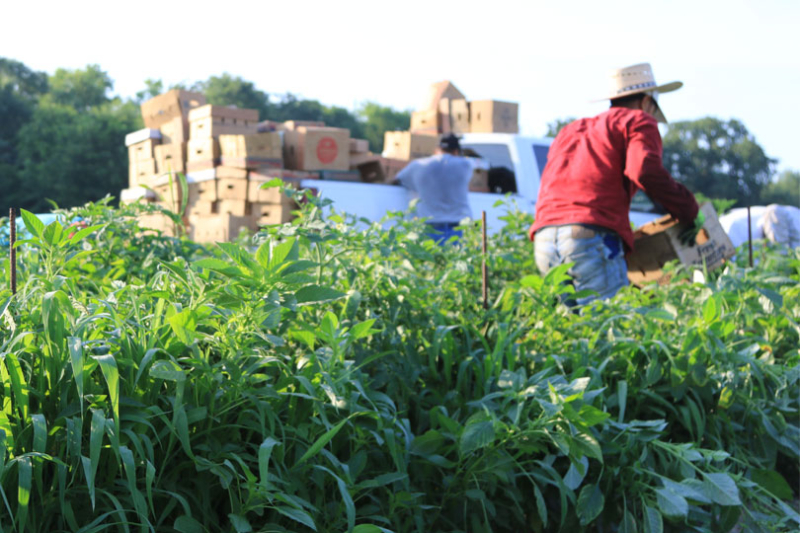By Jessica Domel
Multimedia Reporter
The Trump administration is changing the way wage rates are calculated for the H-2A guestworker visa program.
In the Oct. 2 edition of the Federal Register, the Department of Labor (DOL) proposed using the Bureau of Labor Statistics’ Occupational Employment and Wage Statistics Survey (OEWS) to calculate the H-2A program’s Adverse Effect Wage Rate (AEWR).
The American Farm Bureau Federation (AFBF) called the move a “much-needed step toward reforming regulations that have put labor out of reach for many of America’s farmers.”
The rule revises agricultural wage rates for all 50 states and Puerto Rico.
For many farmers, prices for the products they raise are low while production expenses are at record highs, so a fair wage rate is essential,” AFBF President Zippy Duvall said. “In most states, the new rates will help farmers afford to get crops from the fields to the tables of America’s families.”
Previously, the DOL used the U.S. Department of Agriculture’s Farm Labor Survey to calculate the AEWR.
U.S. Secretary of Agriculture Brooke Rollins recently announced the cancellation of that survey.
“It is estimated that U.S. farm labor expenses this year will be over $54 billion while the growth in labor rates is slowing. Since President Trump came on board, it is getting a little bit better, but it still represents a 47% increase since 2020,” Rollins said at the Ag Outlook Forum. “This increase has been driven largely by the high cost of utilizing the H-2A program to secure seasonal labor, specifically the artificially inflated adverse effect wage rate, or the AEWR, set by the Department of Labor using USDA data.”
Rollins said USDA’s Farm Labor Survey was not designed to be used to set government mandated wage rates and is duplicative of other data sources.
“That’s why USDA has discontinued this survey and no longer will it be used to justify what is an unreasonable increase in that average wage rate,” Rollins said.
According to the DOL, the AEWRs for H-2A workers will now be divided into two skill categories to allow for different wage rates for different qualifications.
Employers will also reportedly be able to adjust a worker’s compensation if they receive free housing from the employer.
“This new rule holds promise for many farm families who would be out of business if not for the H-2A program,” Duvall said. “We look forward to working with the administration to ensure more transparency, predictability and clarity as it implements the rule, and we remain committed to working with Congress for more lasting reforms that provide mutual benefit for workers and farmers while ensuring both can continue to stock America’s pantries.”
AFBF and Texas Farm Bureau (TFB) have long advocated for changes to the AEWR. According to the grassroots organizations, labor costs can be nearly half the cost of production, making it hard for farmers to break even and more expensive to grow food domestically.
AFBF reports higher production costs, including through regulatory hurdles and administrative requirements, can ultimately lead to more dependence on imported foods, especially for labor-intensive crops.
“Secretary Lori Chavez-DeRemer took decisive action to fix a broken wage rate system that has threatened the viability of American farms,” TFB President Russell Boening said. “By rolling back burdensome wage rules and establishing a dedicated ‘concierge’ team to streamline guestworker visa processing, she’s made it easier for farmers to find the help they need. These reforms are a lifeline for producers facing rising costs and labor shortages. We sincerely appreciate Secretary DeRemer and her team at the Department of Labor for their commitment to creating a more workable and sustainable ag labor environment.”
Rollins said at the recent Ag Outlook Forum she is working with Labor Secretary Lori Chavez-DeRemer and other members of the administration to make the H-2A program more affordable and accessible.
“Instead of going to three plus federal agencies for the paperwork, Lori has set up a concierge office at the Department of Labor where there will only be one office,” Rollins said. “(Recently), it was announced that the State Department is removing the requirement for H-2A temporary farm workers to attend in-person interviews to renew their visas.”
The DOL estimates the proposed rule will save employers about $2.46 billion.
DOL’s interim final rule went into effect Oct. 2 when it was published in the Federal Register.
Additional details on the changes are available here.


Leave A Comment